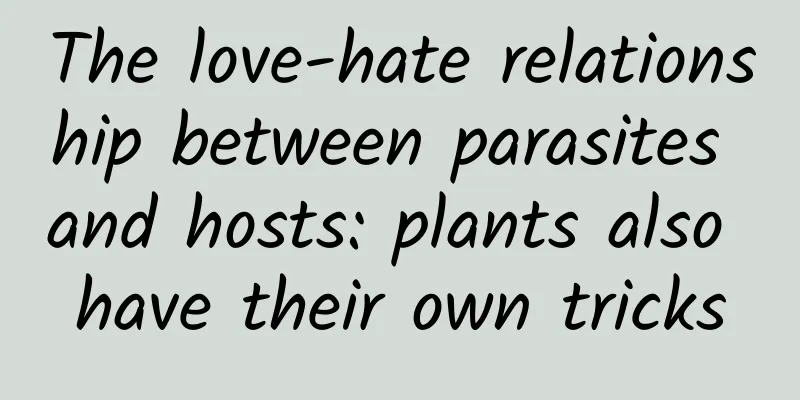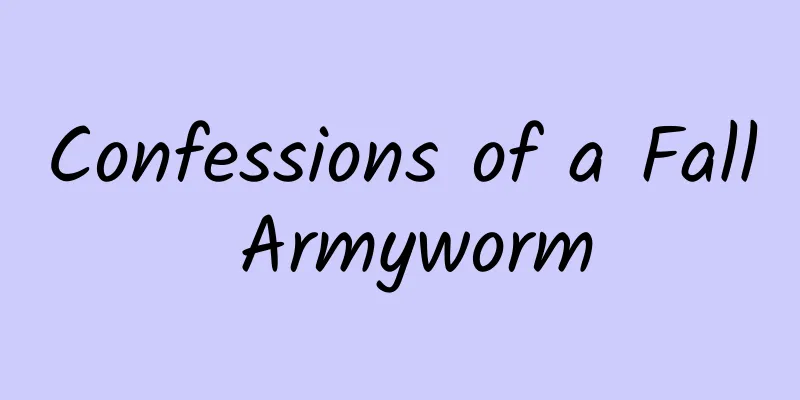The love-hate relationship between parasites and hosts: plants also have their own tricks

|
Produced by: Science Popularization China Author: Himalayan Red Panda Producer: China Science Expo As the saying goes, "It is better to rely on yourself than on others." However, in nature, there are a group of plants that survive and grow by parasitizing and absorbing nutrients from their hosts. At first glance, they sound a bit like "parasites." Today, we will unveil the "mystery" of these plants that "are better to rely on others than on themselves." What are parasitic plants Generally speaking, there are six possible relationships between two species living in a symbiotic relationship, namely mutualism - both parties benefit from the symbiotic relationship, such as fungi and algae in lichens; commensalism - the symbiotic relationship is beneficial to one party and has no obvious harm to the other, such as remora and manta rays; amensalism - the symbiotic relationship is harmful to one party and has no obvious benefit to the other, such as Penicillium and certain bacteria; neutralism - the symbiotic relationship has no obvious benefit or harm to either party, such as living together and shrimp; competition - the two parties compete for common living resources, which is harmful to both parties of the symbiosis, such as rice and barnyard grass; parasitism - the parasite attaches itself to another organism and uses the host's nutrients to survive, such as Cistanche and Haloxylon ammodendron. Six types of symbiosis (Image source: https://en.wikipedia.org/wiki/Biological_interaction) Among them, parasitism is the most unique form of symbiosis, which is widely present in all organisms, including prokaryotes, archaea, animals, plants, fungi and other eukaryotes. Parasitic organisms usually undergo changes in morphology, physiology, genes and other aspects during the evolution process. Today, we have recognized about 292 genera and 4750 species of parasitic plants. Among the 12 parasitic plant groups, Santalumales is the order with the most parasitic plants, while Orobanchaceae is the family with the most parasitic plants. Together, they reveal to us the origin and evolution of parasitic plants. In addition, in the symbiotic process with the host, parasitic plants also co-evolve with the host. In recent years, as scientists have gained a deeper understanding of plant physiology and morphology, it is generally believed that parasitic plants in a broad sense include two categories, namely, haustoria parasitic plants and mycorrhizal heterotrophic plants. Although their phylogenetic relationships are different, these two types of heterotrophic plants share many similarities in physiology, anatomy, development, and life history. The difference is the way they obtain nutrients. Haustoria parasitic plants usually directly invade the xylem or phloem of the host through specialized haustoria formed by roots and stems to directly obtain nutrients, while mycorrhizal heterotrophic plants obtain nutrients from other plants indirectly through mycorrhizal fungi. It is precisely because of this special way of obtaining nutrients that mycorrhizal heterotrophic plants are generally mistakenly considered saprophytes. The parasitic plants introduced in this article only refer to the former type of parasitic plants, namely haustoria parasitic plants. Types of parasitic plants Based on the ability of haustoria parasitic plants to carry out photosynthesis, they can be simply divided into three categories, namely, plants that are fully photosynthetic autotrophic, plants that are only partially photosynthetic autotrophic, and plants that are not photosynthetic autotrophic. The first two have chloroplasts and can perform photosynthesis. Since their nutrition does not come entirely from their host, they are called semi-parasitic plants. Plants that cannot photosynthesize and autotrophically lack chloroplasts, so their nutrition comes entirely from the host, so they are called holoparasitic plants. In addition, the latter two are called obligate parasites because they rely on the host's energy to complete their life cycle. Correspondingly, plants that can be completely photosynthetic autotrophic can live normally in the absence of a host and are therefore called facultative parasites. Differentiation of parasitic plants based on physiological characteristics and life history (Image source: http://parasiticplants.siu.edu/) Phylogeny of parasitic plants In recent years, with the deepening of molecular research, it is generally believed that haustoria parasitic plants have originated independently 12 times in the evolutionary history of angiosperms, belonging to 12 orders, 27 families, 292 genera, and about 4,750 species. Representatives of 12 independent origin parasitic angiosperm groups: A. Laurales, Lauraceae; B. Piperales, Hydnoraceae; C. Saxifragales, Cynomoriaceae; D. Zygophyllales, Krameriaceae; E. Malpighiales, Rafflesiaceae; F. Cucurbitales, Apodanthaceae; G. Malvales, Cytinaceae; H. Santalales, most families; I. Ericales, Mitrastemonaceae; J. Boraginales, Lennoaceae; K. Solanales, Convolvulaceae; L. Lamiaceae, Lamiales, Orobanchaceae. (Image source: Nickrent, DL Parasitic angiosperms: How often and how many? TAXON. 2020 69 (1): 5-21.) A simplified angiosperm phylogenetic tree showing the orders in which parasitic plants are located. Red indicates orders containing parasitic taxa; green indicates semi-parasitic taxa; yellow indicates fully parasitic taxa; white indicates autotrophic taxa; blue indicates that the parasitic form is unknown. (Image source: Nickrent, DL Parasitic angiosperms: How often and how many? TAXON. 2020 69 (1): 5-21.) Among these 12 groups, the majority are semi-parasitic, while the minority are fully parasitic. Among them, there are only two groups that are completely semi-parasitic: Cassytha of Lauraceae and Krameria of Krameriaceae. There are seven groups that are completely parasitic, namely Hydnoraceae, Cynomoriaceae, Rafflesiaceae, Apodanthaceae, Cytinaceae, Mitrastemonaceae, and Lennoaceae. The groups that are both semi-parasitic and fully parasitic include Cuscuta in the Convolvulaceae family, Santales in the Santales order, and Orobanchaceae in the Orobanchaceae family. The latter two happen to be the two largest groups of parasitic plants. There are about 2,428 parasitic plants in the Santales order, and about 2,163 parasitic plants in the Orobanchaceae family. What’s more interesting is that in the phylogenetic tree of these two huge parasitic groups, there are some photosynthetic autotrophic groups at the base that are sister groups of the parasitic groups, which opens a window for scientists to study the evolution of parasitic plants. The phylogenetic tree of the Santalumales has a total of 20 families. It can be seen that the basal 4 families are all photoautotrophic groups, 13 of the remaining 16 families are semi-parasitic, the parasitic form of 1 family is unclear, and 2 fully parasitic families are embedded in the semi-parasitic families. (Image source: Nickrent, DL Parasitic angiosperms: How often and how many? TAXON. 2020 69 (1): 5-21.) For example, according to molecular data, the Santalaceae can be divided into 20 families. The four most basic families are all autotrophic groups. Of the remaining 16 families, 13 are semi-parasitic groups; only two families are holoparasitic groups (Balanophoraceae and Mystropetalaceae), and they are embedded in the semi-parasitic groups. By comparing the phylogenetic relationships between parasitic groups and closely related photoautotrophic groups in the Santalumales, we can draw conclusions about the origin of parasitic plant groups, that is, parasitic groups evolved from photoautotrophic groups, and holoparasitic groups evolved from semi-parasitic groups, and this evolutionary process occurred twice independently in the Santalumales. Constantly adapting to the environment in parasitism **For parasitic plants, **long-term dependence on hosts to complete some physiological activities compresses their evolutionary choices in morphology, physiology and genes. One of these is the disappearance of traits, either because the costs of maintaining a trait in parasitic life exceed its benefits, or because the trait is no longer important for fitness in the parasitic state and is therefore lost through genetic drift. Trait reduction is a common feature of all parasitic plants, but once a key trait is lost, the parasite must rely on the host to fulfill the purpose for which the trait existed. Holoparasitic plants usually lose their chloroplast genomes and cannot live independently. Once the host population decreases or becomes extinct, its parasitic plants will also face a catastrophe. **For the host,** when parasitized by parasitic plants, it may grow slowly. At the same time, its interaction with mycorrhizal fungi, pathogens, pollinators or herbivores will also change adversely. In addition, problems such as increased sensitivity to drought, reduced photosynthesis capacity, reduced offspring, and reduced environmental adaptability will also follow, so parasitic plants also have selection pressure on hosts. Parasite vs. Host: Mutual Pressure A typical obligate parasite has frequent interactions with its host throughout its life, starting from seed germination. First, dormant parasite seeds detect compounds released by nearby host roots, triggering seed germination. Second, the parasite forms haustoria on the host's roots. Finally, the parasite remains attached, absorbing nutrients it needs to grow and reproduce. In these three processes, both sides exert selection pressure on each other. Interactions between parasitic plants and their hosts (Image source: http://parasiticplants.siu.edu/) Seed germination and host camouflage To ensure that there are enough offspring, some parasitic plants can produce tens or hundreds of thousands of seeds. These seeds are usually small and have limited energy reserves. When they germinate, the seedlings must attach to the host within a few days to survive. Some obligate parasites have evolved specialized germination mechanisms that reduce suicidal germination in the parasite. These adaptations primarily involve seed dormancy and signal detection. Seed dormancy usually refers to delaying germination of seeds in the soil for several decades. After a period of conditioning, the seeds can acquire the potential to germinate at a specific time of the year. Signal detection involves the detection of chemical cues from nearby host roots, including strigolactones, which are potent germination stimulants at very low concentrations. For parasitic plants and hosts, strigolactones are essential plant hormones. They are important signals for establishing beneficial symbiotic interactions with arbuscular mycorrhizal fungi (AMF). AMFs can provide water and mineral nutrients, such as phosphates and nitrogen, to host plants in exchange for carbohydrates from the host plants. Strigolactones can promote hyphal branching of AMFs and improve their association efficiency. There are about 20 strigolactones that can be secreted by plants, but the amount and type of strigolactones produced vary from species to species, and even within species. Parasitic plant seeds can select suitable hosts by preferring specific strigolactones. By reducing the release of strigolactones, host plants can also become invisible to the seeds of parasites. In agriculture, crops with low strigolactone release can also be cultivated to resist parasites. Parasitic plant seeds target their hosts by detecting strigolactones released by the host (Image source: http://parasiticplants.siu.edu/) Haustoria invasion and host defense When the seeds of the parasitic plant germinate and detect haustoria-eliciting factors (such as quinones, hydroxy acids, and flavonoids) in the host root exudates, the parasitic plant will begin to specialize its invasive structure. The haustorium first invades the host through the epidermis and cortex of the host's roots, and then forms a xylem connection between the two hosts. The host generally intercepts the haustorium through physical and chemical means. Typically in the roots of some plants, a tough endodermis prevents further invasion of haustoria, while phenols, phytoalexins, and other secreted compounds in the roots can delay the development or invasion of haustoria, ultimately achieving a defensive purpose. The corky inner bark of corn protects the xylem from parasitic plants (Image source: http://parasiticplants.siu.edu/) Host's "resistance" - toxic effects After attaching to the host's xylem (and sometimes phloem), the plant begins to absorb nutrients from the host. Obligate holoparasites must remain attached to their host to grow and reproduce, completing their life cycle. The ability to maintain a continuous and open vascular connection to the host root system is an important prerequisite for stimulating a host response. Some hosts are already capable of defensive responses, which close the vascular connection to the host plant by blocking the host's own vascular tissue or producing toxic compounds that can diffuse throughout the host plant. In addition, interfering with the differentiation of vascular tissues in parasitic plants is also a defensive response of some hosts. At present, relevant resistance genes have been found in some wild varieties of corn and sunflowers. These resistance genes can effectively prevent the development of parasitic plants and have important uses in agriculture. Misunderstood parasites In agriculture and forestry, some parasitic plants are classified as "harmful plants" because they affect the normal growth and development of their hosts. But in fact, although these plants can damage agricultural and forestry crops, they are also important cornerstones of local ecosystems. Parasitic plants play an important and positive role in the competition between organisms, material circulation, energy flow, information transmission, and the diversity of ecosystems. In addition, more molecular morphological studies related to parasitic plants, especially the evolutionary studies of parasitic plants and their closely related autotrophic groups, are gradually revealing key issues in phylogenetics and evolutionary biology, laying the foundation for the development of modern taxonomy. Conclusion Some people may want to accuse parasitic plants of their characteristics, but from the perspective of parasitic plants, they have simply taken a different path under the pressure of selection. At present, many parasitic plants are facing the risk of extinction, such as Bacardi, Cistanche deserticola, Cynomorium songaricum, etc., which are hailed as the so-called "rejuvenation grass" and "aphrodisiac grass" due to their unique plant shapes. They are being excavated on a large scale. The populations of these plants are seriously threatened and urgently need our attention and protection. Editor: Ying Yike References: 【1】Martin et al. Symbiosis: 'Living together' in chaos, Studies in the History of Biology. 2012. 4 (4): 7-25. 【2】Poulin, R. Rollinson, D. The Many Roads to Parasitism: A Tale of Convergence. Advances in Parasitology. Academic Press. 2011. 74: 27-28. 【3】Dörr, I. How Striga Parasitizes its Host: a TEM and SEM Study. Annals of Botany. Oxford University Press. 1997. 79(5): 463-472. 【4】Bromham, L., Cowman, P. & Lanfear, R. Parasitic plants have increased rates of molecular evolution across all three genomes. BMC Evol. Biol. 2013 13: 126. 【5】Su et al. Novel genetic code and recordsetting AT-richness in the highly reduced plastid genome of the holoparasitic plant Balanophora. Proc. Natl. Acad. Sci. USA 2019. 116: 934-943. 【6】Yang et al. Horizontal gene transfer is more frequent with increased heterotrophy and contributes to parasite adaptation. Proc. Natl. Acad. Sci. USA 2016. 113: E7010-E7019. 【7】Hatcher, MJ, Dick, JT & Dunn, AM Diverse effects of parasites in ecosystems: Linking interdependent processes. Frontiers Ecol. Environm. 2012 10: 186-194. 【8】Wang, Y. & Bouwmeester, HJ Structural diversity in the strigolactones. J. Exp. Bot. 2018. 69: 2219-2230. 【9】Nickrent, DL Parasitic plants. in: McGraw-Hill Yearbook of science and technology. New York: MacGraw-Hill. 2008. Pp. 251-253. 【10】Nickrent, DL Parasitic angiosperms: How often and how many? TAXON. 2020 69(1): 5-21. 【11】APG IV. An update of the Angiosperm Phylogeny Group classification for the orders and families of flowering plants: APG IV. Bot. J. Linn. Soc. 2016. 181: 1-20. 【12】Nickrent, DL Malécot, V. Vidal-Russell, R. Der, JP A revised classification of Santalales. TAXON. 2010. 59 (2): 538-558. 【13】Nickrent, DL, Anderson, F. & Kuijt, J. Inflorescence evolution in Santalales: Integrating morphological characters and molecular phylogenetics. Amer. J. Bot. 2019. 106: 402-414. 【14】Su, H.-J., Hu, J.-M., Anderson, FE & Nickrent, DL Phylogenetic relationships of Santalales with insights into the origins of holoparasitic Balanophoraceae. TAXON. 2015. 64: 491-506. 【15】Yu, W., Randle, CP, Lu, L., Wang, H., Yang, J., dePamphilis, CW, Corlett, RT & Li, D. The hemiparasitic plant Phtheirospermum (Orobanchaceae) is polyphyletic and contains crypticspecies in the Hengduan Mountains of Southwest China. Frontiers Pl. Sci. 2018. 9: 142. 【16】Watling, JR, Press, MC Impacts of Infection by Parasitic Angiosperms on Host Photosynthesis. Plant biology. 2001. 3: 244-250. 【17】Xie, X., Yoneyama, K., Yoneyama, K. The Strigolactone Story. Annual Reviews of Phytopathology. 2010. 48: 93-117. 【18】Fernández-Aparicio, M., Flores, F., Rubiales, D. Recognition of root exudates by seeds of broomrape (Orobanche and Phelipanche) species. Annals of Botany. 2009. 103: 423-431. 【19】López-Ráez, JA, Pozo, MJ, García-Garrido, JM Strigolactones: a cry for help in the rhizosphere. Botany. 2001. 89: 513-522. 【20】Xie, 153-163. 【21】Jamil, M., Rodenburg, J., Charnikhova, T., Bouwmeester, HJ Pre-attachment Striga hermonthica resistance of New Rice for Africa (NERICA) cultivars based on low strigolactone production. New Phytologist 2011. 192: 964-975. 【22】Westwood, JH, Yoder, JI, Timko, MP, dePamphilis, CW The evolution of parasitism in plants. Trends in Plant Science 2010. 15: 227-235. 【23】Amusan, IO, Rich, PJ, Menkir, A., Housley, T., Ejeta, G. Resistance to Striga hermonthica in a maize inbred line derived from Zea diploperennis. New Phytologist 2012. 178: 157-166. |
<<: A washcloth, wiped from head to toe! Huaxi doctor: Oh my god, you can’t even wash your face?
>>: We often hear that “pull out one grey hair and ten will grow back”? Is this true?
Recommend
2500 words user retention analysis
Faced with the current situation of difficulty in...
Do girls have any physiological reactions when kissing? How does it feel when a girl kisses you?
Kissing is a way for boyfriends and girlfriends t...
Huawei files lawsuit in the US: ban is "legislation instead of trial"
According to CCTV News Client on the 29th, Huawei...
How is the interest on early repayment of Youqianhua calculated? How much is the interest on the money spent per month?
Many people choose Youqianhua when they want to b...
The urine of a 26-year-old programmer actually attracted a group of ants! When the body sends these signals, you should be careful
Recently, such a piece of news has attracted peop...
How to operate a mini program? It is easy for Xiaobai to get
For those who continue to pay attention to mini p...
Ideal ONE overturned a motorcycle due to a broken axle, and the official accused it of being a rumor. The person involved responded that it was indeed man-made.
On February 4, Ideal Auto officially announced th...
Should we cut advertising budgets during the epidemic? Shouldn’t!
Some time ago, I wrote an article titled "Wh...
User-centric? Why not sit down and do an in-depth user interview?
"User-centric" is the consensus of Inte...
Cao Cao VS Liu Bei, where should the male god Guan Yu go?
Mixed Knowledge Specially designed to cure confus...
Nearly 10,000-word strategic notes for startups. After reading this, you will be excited to start your own business!
[[141699]] Huxiu Note: This article is from The M...
A 6-year-old boy was infected with a rare "brain-eating worm" while swimming at the beach! There is currently no specific medicine, and the mortality rate is as high as over 90%!
"My original intention was to take my child ...
Microsoft Office 2016 creates mobile office solutions for large and medium-sized enterprises!
Over the past few decades, Microsoft's Window...
Hand, foot and mouth disease enters its peak season! China CDC issues health tips →
When spring arrives, all things come to life, and...
If you are 177cm tall, don’t try to adjust the seat of a shared bicycle to 180cm!
Anyone who can ride a bike must have ridden the s...









